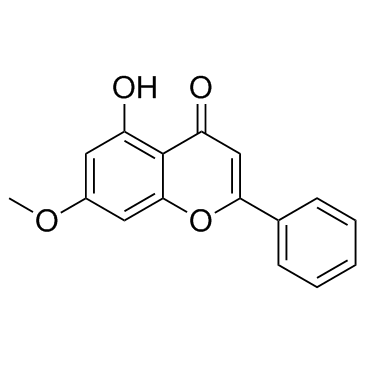Tectochrysin (Techtochrysin) (Synonyms: 5-Hydroxy-7-methoxyflavone, NSC 80687, Tectochrysin) |
| Catalog No.GC34171 |
Tectochrysin (Techtochrysin) (Techtochrysin) is one of the major flavonoids of Alpinia oxyphylla Miquel. Tectochrysin (Techtochrysin) inhibits activity of NF-κB.
Products are for research use only. Not for human use. We do not sell to patients.

Cas No.: 520-28-5
Sample solution is provided at 25 µL, 10mM.
Tectochrysin (Techtochrysin) is one of the major flavonoids of Alpinia oxyphylla Miquel. Tectochrysin (Techtochrysin) inhibits activity of NF-κB.
Tectochrysin (Techtochrysin) inhibits activity of NF-κB. Tectochrysin (Techtochrysin) binds directly to the p50 unit. Tectochrysin (Techtochrysin) concentration-dependently inhibits the translocation of p50 and p65 into the nucleus through inhibition of the phosphorylation of IκB. To assess the inhibitory effect of Tectochrysin on cell growth of colon cancer cells (SW480, HCT116), cell viability is analyzed by MTT assay. The cells are treated with varying concentrations of Tectochrysin (Techtochrysin) (1, 5, 10 μg/mL) for 24 h. Tectochrysin (Techtochrysin) inhibits cell growth in colon cancer cells in a concentration-dependent manner. Tectochrysin (Techtochrysin) inhibits SW480 cells growth with IC50 value of 6.3 μg/mL and HCT116 cells growth with IC50 value of 8.4 μg/mL. Morphologic observation shows that the cells are reduced in size by the treatment of NSC 80687 (10 μg/mL) in SW480 cells and HCT116 cells. However, Tectochrysin (Techtochrysin) is not cytotoxic in the normal CCD-18co cells in the tested concentration by MTT assay. To delineate whether the induction of apoptotic cell death is critical for cell growth inhibition by NSC 80687, changes are evaluated in the chromatin morphology of cells using DAPI staining. To further characterize the apoptotic cell death by Tectochrysin (Techtochrysin), TUNEL staining assays are performed, and then the labeled cells are analyzed by fluorescence microscopy. Apoptotic cells number (DAPI-positive TUNEL stained cells) in SW480 cell is increased to 1 and 58 % by 0 and 10 μg/mL NSC 80687, respectively, and 1 and 54 % by 0 and 10 μg/mL Tectochrysin in HCT116[1].
To elucidate the antitumor effects of Tectochrysin in in vivo, the tumor growth in colon cancer xenograft-bearing nude mice following Tectochrysin (NSC 80687) treatments is investigated. In HCT116 xenograft studies, Tectochrysin (NSC 80687) is administrated i.p. twice per week for 3 weeks to mice with tumors ranging from 200 to 300 mm3 in volume. The mice are weighed twice per week. The changes in body weights between the control and the Tectochrysin (NSC 80687)-treated mice (n=10) are not remarkably different during the experiment. However, On day 21, the final tumor weights are recorded. Tumor weights and volumes in mice treated with Tectochrysin (NSC 80687) at 5 mg/kg doses are 57.9 % and 46.4 % of the vehicle group, respectively[1].
[1]. Park MH, et al. Anticancer effect of Tectochrysin in colon cancer cell via suppression of NF-kappaB activity and enhancement of death receptor expression. Mol Cancer. 2015 Jun 30;14:124.
Average Rating: 5 (Based on Reviews and 36 reference(s) in Google Scholar.)
GLPBIO products are for RESEARCH USE ONLY. Please make sure your review or question is research based.
Required fields are marked with *




















